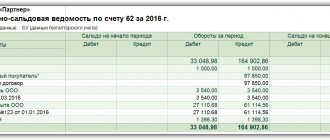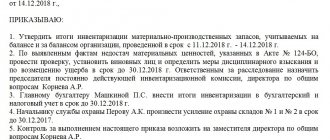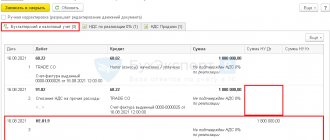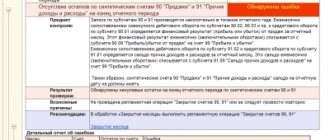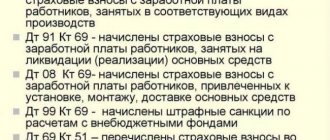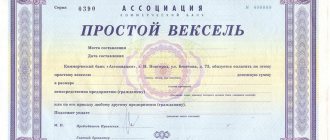Settlements with customers are carried out on accounting account 62. What are the features of accounting for settlements with customers, accounting entries for account 62 will be discussed in this article. We will also consider how bills and advances received from the buyer are accounted for?
The shipment of goods to the buyer, the provision of services or the performance of work forms a receivable from the buyer to the organization by the seller. The debit of account 62 shows exactly the amount of this debt. The debt arises due to the fact that the shipment to the buyer occurs before payment for it is received.
Settlements with customers are periodically reconciled; this is done using an inventory of settlements with debtors and creditors.
Purpose of account 62
The account is intended to record information about transactions with counterparties purchasing its goods (work, services) from the organization. As a general rule, account 62 reflects transactions on those products of the organization that relate to its main activities. To record one-time or atypical transactions for an organization, account 76 of the chart of accounts is intended (approved by order of the Ministry of Finance dated October 31, 2000 No. 94n).
All the features of filling out the register for settlements with customers are given in the article “Features of the balance sheet for account 62”.
Account 51 “Current accounts”
Account 51 “Current accounts” is intended to summarize information on the availability and movement of funds in the currency of the Russian Federation on the organization’s current accounts opened with credit institutions.
The debit of account 51 “Settlement accounts” reflects the receipt of funds to the organization’s settlement accounts. The credit of account 51 “Current accounts” reflects the write-off of funds from the organization’s current accounts. Amounts erroneously credited or debited to the organization's current account and discovered when checking statements of a credit institution are reflected in account 76 “Settlements with various debtors and creditors” (sub-account “Settlements for claims”).
Transactions on the current account are reflected in accounting on the basis of the credit institution's statements on the current account and the monetary settlement documents attached to them.
Analytical accounting for account 51 “Current accounts” is maintained for each current account.
The nuances of using subaccounts using the example: Dt 62.1 Kt 62.2
On account 62, analytical accounting should be provided according to the following parameters:
- According to issued invoices.
- For each counterparty.
- By groups of affiliated persons (with whom consolidated reporting should then be prepared).
- By payment characteristics (received prepayments, postpayments).
These tasks are solved, among other things, through the opening of sub-accounts to account 62.
Subaccounts are usually identified by an additional numeric coding of one or two characters added to the main account code. In the original chart of accounts, a unified standard for creating subaccounts for account 62 is not provided. But as a result of the widespread use of computer programs, assigning a subaccount code in practice is approximately the same.
For example:
- Account 62.1 (or 62.01 in most current versions of accounting programs) is assigned to account for postpaid settlements. When the goods have been shipped (services have been provided) but payment has not yet been received. The balance according to 62.1 is debit and means that the buyer (customer) owes the organization for the part of the transaction that it has already completed.
- Account 62.2 (or 62.02) is used to record received payments against future shipments (performance of work, provision of services). The balance is a credit balance and characterizes the size of the organization’s obligations to counterparties who have made prepayments for transactions.
Read more about accounting automation in the material “Review of programs for accounting expenses and income of an organization.”
Account 51 Current accounts. Typical transactions for 51 accounts
Debit account 70 − Credit account 94
On the basis of what documents are entries made on the synthetic account 50 “Cash”?
Incoming and outgoing cash orders.
What does the accounting entry reflect: Debit account 07 − Credit
bills 60?
Purchase of equipment for installation.
Which account is debited when transferring funds for the delivery of materials to a transport organization?
Account 60 “Settlements with suppliers and contractors.”
. What accounting entry is made when fuel is supplied to the boiler room of the plant:
3. Debit account 23 − Credit account 15.
What does the accounting entry mean: Debit of account 25 “General business expenses” - Credit of account 02 “Depreciation of fixed assets”, subaccount “Depreciation of own fixed assets”?
Calculation of depreciation on fixed assets for general workshop purposes.
. How are the transferred funds reflected in the budget?
4. Debit account 68 − Credit account 51.
What account are petroleum products received from suppliers accounted for?
Account 10 “Materials”.
Which accounting entry reflects the receipt of purchased semi-finished products at the plant?
Debit account 10 - Credit account 60
What accounting entry is made when recording materials received during the liquidation of fixed assets?
1. Debit account 10 − Credit account 91.
. What accounting entry is made when new fixed assets are received free of charge?
Debit account 08 – Credit account 98
What are sold products if the accounting policy of the enterprise provides for the determination of revenue by payment?
Products paid for by the buyer.
. What does the accounting entry mean: Debit account 02 – Credit account 01?
Write-off of depreciation on retired fixed assets.
What does the accounting entry mean: Debit of account 91 “Other expenses and income” - Credit of account 01 “Fixed assets”?
Disposal of fixed assets at residual value.
What is the meaning of the entry: Debit account 45 “Goods shipped” - Credit account 43 “Finished products”:
Products were shipped for export or on a commission basis.
What is profit from product sales?
The difference between revenue from sales of products and its full actual cost.
What is reflected in the debit of account 45 “Goods shipped”?
Shipment of finished products (goods) or transfer them for sale on a commission basis.
Which accounting entry should reflect the business transaction: “The cost price is reflected when recognizing revenue for shipped goods and finished products”?
Debit account 90 – Credit account 43.
Is depreciation calculated after the end of the depreciation period?
Not credited.
. What accounting entry is made when capitalizing fixed assets contributed by the founders as a contribution to the authorized capital?
Debit account 08 – Credit account 75.
What accounting entry should be made to write off shop expenses (expenses) of the assembly shop?
Debit account 20 – Credit account 25.
What is total cost of goods sold?
The sum of the actual production cost of goods sold and selling expenses.
How to reflect receipts for sold products (for non-cash payments) if the enterprise’s accounting policy provides for determining revenue by shipment?
Debit account 51 – Credit account 62.
Which accounting entry should reflect the write-off of the financial result from the sale of products (profit)?
Goods accounts
In accounting, goods are recorded in account 41 “Goods”. In the Instructions for the application of the Chart of Accounts, approved by Order of the Ministry of Finance of the Russian Federation No. 94n dated October 31, 2000.
What does the posting Debit 62 Credit 62 mean?
Posting Dt 62 Kt 62 always means making changes according to calculations. There are three possible options:
- Debit 62 Credit 62 between subaccounts.
Example
is part of a group of companies preparing consolidated financial statements. Technotrade accounts for settlements with companies in its group in account 62.4. The company has a counterparty, LLC "Zapchasti", which has a credit balance of 62.2. received information that Zapchasti LLC was included in the same group on the date the balance was formed. That is, settlements with Zapchasti LLC will be considered intra-group. Technotrade LLC is posting Dt 62 Kt 62 (Dt 62.2 Kt 62.4) for the amount of the advance payment from Spare Parts LLC.
- Debit 62 Credit 62 between counterparties.
Example
Stroymontazh LLC performed repair work for the customer 1 per 100,000 rubles. and customer 2 for 80,000 rubles. The customers are affiliated persons, resulting in payment under both contracts in the amount of 180,000 rubles. received from customer 1. Stroymontazh LLC accepted this payment, securing its terms in an additional agreement with customers. To correctly reflect the calculations, the accountant of Stroymontazh LLC made a posting of Dt 62 / customer 1 Kt 62 / customer 2 for 80,000 rubles.
- Debit 62 Credit 62 for two transactions.
Example
Stroymontazh LLC contracted to perform work at several sites of one customer. At site 1, the work has been completed, but not all of it has been paid for. An advance payment has been received for object 2, but work is still underway. The customer proposed to offset part of the prepayment for object 2 to pay off his debt for object 1. According to the corresponding additional agreement, Stroymontazh LLC will make an entry in its accounting Dt 62 / customer / object 2 Kt 62 / customer / object 1 for the balance of the customer’s debt for the object 1.
Wiring Dt 62 Kt 90 and Dt 62 Kt 91
Debit 62 Credit 90 and Debit 62 Credit 91 appear in accounting in connection with the receipt of income by the organization.
Dt 62 Kt 90 means reflecting revenue from main activities.
Dt 62 Kt 91 will be needed to reflect other operations. This may include income from:
- from the sale of fixed assets;
- from external sales of materials;
- from writing off expired accounts payable.
For an example of accounting entries for mutual settlements with buyers and customers, see.
Read more about this in the article “Writing off accounts payable with an expired statute of limitations.”
Account 51 in accounting: meaning, postings and examples
51 “Current account” is used by organizations and individual entrepreneurs to display transactions on mutual settlements with counterparties - individuals and legal entities in the currency of the Russian Federation using company current accounts opened in credit institutions.
51 accounts in accounting is the collection of information about non-cash payments made with counterparties - individuals and legal entities through bank accounts. The following basic operations are displayed here:
- Receipt of funds - payments from buyers and customers for goods provided or services provided;
- Depositing trading proceeds in excess of established cash limits;
- Payment to suppliers for raw materials, materials, goods
- Payroll calculations
- Calculations with budgets (transfer of contributions, taxes, penalties), etc.
Attention! Account 51 displays information about settlements only in the currency of the Russian Federation.
Account 51 in accounting is active, that is, the debit shows non-cash receipts of funds (payments from customers, deposits of revenue, returns from suppliers) in correspondence with the corresponding accounts (62, 50, etc.), and the credit shows the expenditure of funds ( bank commissions, payments to suppliers, repayment of loans and borrowings, payment of taxes, etc.)
Wiring Dt 62 Kt 76
In its meaning, the posting is similar to the posting Debit 62 Credit 62 and means some change either in the type of settlement or in the status of the counterparty. Only for transferring debt amounts, not an analytical account is used for account 62, but account 76. In this case, account 76 takes into account transactions that are not mentioned in the instructions for accounts 60 to 75. Including, in relation to buyers and customers, these may be calculations:
- for transactions that differ from ordinary transactions in the main activity;
- on insurance and intermediation operations;
- on claims (for example, on fines for violation of contract terms).
Example
The carrier company transported a consignment of the customer’s goods and additionally arranged insurance for these goods en route. To ensure analytical accounting, the carrier company accountant divided the total invoice amount presented to the customer into services for the main activity (transportation) and additional insurance services:
Dt 62 Kt 76 - for the amount of the cost of insurance of the customer’s cargo.
D 01 K 91 subaccount “Other income”
Purchased books, brochures and other publications may be written off as production costs as they are released into production or operation. Accounting for purchased publications as fixed assets is possible only if there is a library fund. Correspondence of accounting accounts for transactions of acquisition and transfer of books into operation:
D 08 K 60(71)¾accepted books at nominal acquisition cost;
D 19 K 60¾ VAT presented by the supplier is taken into account;
D 01 K 08 ¾ books were transferred for use;
D 26(44) K 01 ¾ the cost is written off upon transfer for use.
The choice of the option of reflecting books and brochures on accounting accounts will not affect the financial statements and the amount of taxes, but this choice determines which forms of primary documents will be filled out: documents reflecting the movement of fixed assets or documents reflecting the movement of inventory.
(3)
Based on decapitalization methods, fixed assets can be grouped as follows:
objects whose value is not decapitalized (depreciated), since their consumer properties do not change over time. These include land plots, natural resources and works of art;
objects that wear out, but in accordance with current legislation are not depreciated. These include: housing facilities (if they are not used to generate income), external improvement facilities and other similar facilities (forestry facilities, road facilities, etc.); perennial plantings that have not reached operational age. For the specified fixed assets and non-profit fixed assets, at the end of the reporting year, depreciation is accrued according to established depreciation rates (on off-balance sheet account 010 “Depreciation of fixed assets”). Clause 17 of PBU 6/01 contains a list of fixed assets, the cost of which is not repaid, i.e. depreciation is not accrued for these objects, but depreciation is accrued at the end of the reporting year according to established depreciation rates;
objects, the cost of which is allowed to be written off as production costs (selling expenses) as they are released into production and operation as part of inventories. These include fixed assets worth no more than the established limit per unit (RUB 20,000), as well as purchased books, brochures and similar publications. In order to ensure the safety of these objects, proper control over their movement must be organized;
objects that are subject to decapitalization through depreciation.
The cost of an organization's fixed assets is repaid through straight-line or accelerated depreciation over its useful life. Only during the conservation of objects does depreciation on them stop. The duration of preservation must be at least three months. Currently, depreciation is calculated regardless of the results of the organization’s economic activities in the reporting period in one of the following ways:
Ø linear method;
Ø reducing balance method;
Ø method of writing off value by the sum of the numbers of years of useful life;
Ø method of writing off cost in proportion to the volume of products (works).
During the reporting year, depreciation charges for fixed assets are accrued monthly, regardless of the accrual method used, in the amount of 1/12 of the annual amount.
The objects for calculating depreciation are fixed assets that are the property of the organization, accepted for economic management and operational management. The amounts of depreciation charges for fixed assets are recorded in accounting by accumulating them during the depreciation period on synthetic account 02 “Depreciation of fixed assets.” The chosen method of calculating depreciation must be applied throughout the entire useful life of the asset. Fixed assets worth no more than 20,000 rubles. are taken into account as part of inventories and are written off as they are released into production.
With the linear method, the annual amount of depreciation is determined based on the initial, current, replacement (in case of revaluation) cost of the fixed asset and the average annual depreciation rate calculated based on its useful life.
With the reducing balance method, the annual amount of depreciation is determined based on the residual value of the fixed asset item at the beginning of the reporting year and the depreciation rate calculated based on the useful life of this item and the acceleration factor.
Ost. St-th×depreciation rate
Depreciation rate = to/life of use
When using the method of writing off cost by the sum of the number of years of its useful life, the initial cost of the fixed asset is multiplied by the ratio of the number of years of the remaining service life of the object and the sum of the number of years of its service life.
Perv. Or ost. We're standing. × number of years until the end/sum of numbers of years
When writing off the cost in proportion to the volume of products (work), depreciation charges are calculated by multiplying the initial cost of the object (completed work) and their estimated (calculated) value for the entire useful life of the object.
Perv. We're standing. /estimated volume ×actual volume
For fixed assets that were in operation before acquisition, the expected useful life of the next owner is determined by subtracting the time of their actual use until the moment of sale or transfer from the service life of new objects. To apply independently calculated depreciation rates for purchased fixed assets that were previously in use, the buyer should obtain from the seller documents confirming the period of actual use of the purchased objects. If an object is purchased whose useful life has reached its standard service life, the possible period of its further use is determined by the buyer independently.
Depreciation is charged monthly on newly registered fixed assets starting from the 1st day of the month following the month of receipt. For retired objects, depreciation is stopped on the 1st day of the month following the month of their retirement or complete write-off. The amount of accrued depreciation of fixed assets is included in production costs (selling expenses) and is recorded on account 02 in the corresponding sub-accounts opened on the basis of property ownership.
D 20, 23 (if direct costs) K 02 for the corresponding subaccounts;
For fixed assets of the main production of business entities, in the calculation of the cost of production of which depreciation is highlighted as a separate item, as well as if the costs of servicing and managing auxiliary production are taken into account in the corresponding account.
D 25, 26 (if indirect costs) K 02 for the corresponding subaccounts;
In the first case, depreciation is calculated on buildings, structures, machinery and equipment of the workshop. In the second ¾ of fixed assets of a general plant nature.
Print (Ctrl+P)
Information for 1C users: Integrated automation 1.1
Analytical monitoring
According to current legislation, legal entities have the right to open any number of accounts necessary to carry out their activities, both in Russian and foreign currency. Data on the opening are automatically transmitted to the Federal Tax Service inspection where the company is registered.
Analysis of incoming and outgoing non-cash funds is carried out in the context of each individual current account opened by the organization.
In order to verify the correctness of mutual settlements and filling in information in the company’s accounting records, an extract is requested from the credit institution (through the Bank-client system or in person through the branch operator). The statement displays all performed transactions and payment documents for them. Balances at the beginning and end of the period, as well as all turnover in accounting, must be identical to information from the bank.
Attention! Credit organizations set their own additional tariffs for servicing the company; amounts are debited automatically on the first or last day of the month, depending on the bank’s policy - these amounts are displayed in accounting as expenses for banking services in correspondence with account 91.02.
Document “Determination of Financial Results” and Document “Closing of the Year”
Basic provisions
The financial result (profit or loss) of the current month is reflected in a separate synthetic account 99 “Profits and losses”.
- Debit 99 – Losses (losses, expenses)
- Credit 99- Profits (income)
Turnover 99 (Dt-Kt) – Final financial result (net profit or net loss for the month). In this case, net profit is the amount of profit of the current reporting period minus the income tax due for payment to the budget.
Account 99 has the following sub-accounts:
- 01 Profits and losses (excluding income tax)
- 02 Income tax
- 09 Other profits and losses
Account 99 has correspondence with many accounts, but in this information we are only interested in the following transactions:
- Amount of profit from sales for the month – Dt 90.9/Kt99.01
- Amount of loss from sale for the month – Dt 99.01/Kt90.9
- Profits from other activities for the month: Dt 91.9/ Kt 99.01
- Losses from other activities for the month; Dt 99.01/Kt 91.9
- Retained earnings for the year Dt 99.01/Kt 84.01
- Uncovered loss for the year Dt 84.02/ Kt 99.01
The document “Determination of financial results” is used to calculate the amounts 90.09 and 91.01 and make postings No. 1, No. 2, No. 3 and No. 4 at the end of the month.
The “Closing of the Year” document is available for conducting only for the period “December” and will happen to reform the balance at the end of the year, namely, all balances of subaccounts of accounts 90 and 91 of accounting are written off to the corresponding subaccounts with code 9. All balances of subaccounts of account 99 “Other income and expenses” are written off to account 99.01.1, and the balance of this account is written off to account 84 “Retained earnings (uncovered loss)” (entries No. 5 and No. 6).
Important! Accounts 90 and 91 should not have a balance every month, but the subaccounts of account 90 and 91 have a balance at the end of each reporting month. At the end of each year, after determining the financial results, it is necessary to carry out a “year closing” document to close the subaccounts of accounts 90 and 91
Closing account 90 - Sale
Account 90 – Sales has the following subaccounts
- 01 Revenue
- 02 Cost of sales
- 03 Value added tax
- 04 Excise taxes
- 05 Export duties
- 07 Selling expenses
- 08 Administrative expenses
- 09 Profit/loss from sales
When posting the document “Determination of financial results” with the “Closing account 90” checkbox checked, the financial result reflected during the month on account 90 “Sales” will be calculated and a transaction will be generated to write off the identified result from subaccount 90.09 “Profit / loss from sales” to the account 99.01 “Profits and losses (except for income tax).”
Financial result (Profit / loss) is determined by the formula:
Result = Kt90.01 – (Dt 90.02-Kt90.02) – (Dt 90.03 – Kt90.03) – (Dt 90.04 – Kt90.04) – (Dt90.05-Kt90.05)
That is, the financial result is determined by the turnover of the loan 90.01 minus the turnover of accounts 90.02,90.03, 90.04,90.05
If the result > 0, then the organization made a profit in the reporting month.
The amount of profit is reflected by the posting: Dt 90.9/Kt99.01
If the result is < 0, then the organization suffered a loss in the reporting month.
The amount of loss is reflected by the posting: Dt 99.01/Kt90.9
Thus, the subaccounts of account 90 “Sales” have a balance at the end of each reporting month, but account 90 itself should not have a balance at the end of the month. At the end of the year, all subaccounts of account 90 that have a balance must be closed with the document “closing the year”
Subaccounts are closed using the following transactions:
Dt90.1/Kt90.9 – closing account 90.1 “Revenue” at the end of the year.
Dt90.9/Kt 90.2 – closing account 90.2 “Cost of sales” at the end of the year.
Dt 90.9/ Kt 90.3 – closing of account 90.3 “VAT” at the end of the year.
D 90.9 / K 90.4 – closing of account 90.4 “Excise taxes” at the end of the year
D 90.9 / K 90.5 – closing of account 90.5 “Export duties” at the end of the year.
Closing account 91 “Other income and expenses”
Account 91 has the following sub-accounts:
91.01 Other income
91.02 Other expenses
91.09 Balance of other income and expenses
The financial result for account 91 represents the Balance of other income and expenses. At the end of each month it is determined by the formula
Result = Kt 91.1 – Dt 91.2.
If Result > 0, then the organization has made a profit (credit balance) and is reflected by posting
Dt 91.9/ Kt 99.01 – reflection of profit from other activities;
If Result < 0, then the organization received a loss (debit balance) and is reflected by posting
Dt 99.01/Kt 91.09 – reflection of losses from other activities;
At the end of the year, all subaccounts of account 91 must be closed with the document “Closing the Year”. When posting a year-end closing document, the following postings are made:
Dt 91.01/Kt 91.09 – subaccount 91.1 is closed at the end of the year.
Dt 91.09/ Kt 91.02 – subaccount 91.2 is closed at the end of the year.
Closing account 99 “Profits and losses” at the end of the year in correspondence with account 84
Account 84 - Retained earnings (uncovered loss) has the following subaccounts
- 01 Profit to be distributed
- 02 Loss to be covered
- 03 Retained earnings in circulation
- 04 Retained earnings used
At the end of the year, December 31, account 99 “Profits and losses” is closed with a document closing the year.
If at the end of the year the organization made a profit, then the following entry is generated:
Dt 99.01/Kt 84.01 – reflects the net profit of the reporting year.
If there is a loss, then the posting:
Dt 84.02 / Kt 99.01 – the uncovered loss of the reporting year is reflected.
Preparation and submission of annual reports is just around the corner. One of the most important indicators of the balance sheet is debt to suppliers and contractors. As you know, in the balance sheet it is reflected in Line 621 “Suppliers and contractors”. Here they indicate the debt to partners for received and unpaid material assets (work performed, services rendered). This debt is taken into account under the credit of account 60 “Settlements with suppliers and contractors”. And on Line 621, record the credit balance on this account at the end of the year.
We create debt to suppliers and contractors Debt to the supplier arises after the capitalization of material assets (acceptance of work performed, services rendered).
Example
In 2005, ZAO Aktiv purchased materials in the amount of 118,000 rubles. (including VAT - 18,000 rubles). At the end of 2005, materials had not been paid for.
The Aktiva accountant made the following entries:
DEBIT 10 CREDIT 60
– 100,000 rub. (118,000 – 18,000) – materials were capitalized;
DEBIT 19 CREDIT 60
– 18,000 rub. – VAT on materials is taken into account (based on the supplier’s invoice).
On line 621 of the balance sheet for 2005 “Asset”, the accountant indicated accounts payable to the supplier in the amount of 118,000 rubles.
If you have a debt in foreign currency, then convert it into rubles at the official exchange rate of the Bank of Russia on the day it is reflected in the accounting records. Do the same recalculation:
